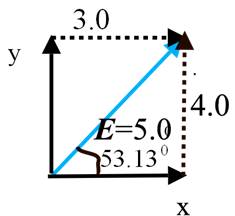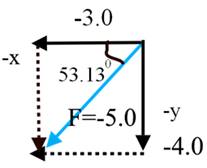
Concept explainers
(a)
The horizontal and vertical components of the given vector.
(a)
Answer to Problem 56A
The horizontal and vertical components of the vector E are
Explanation of Solution
Given:
A vector E with its length 5. Up and positive directions are assumed positive.
Formula Used:
The horizontal and vertical component of a vector R is given by,
The length or magnitude of a vector is expressed as,
The angle is given by,
Calculation:
For the given magnitude of the vector E which is 5.0 units, the possible perfect square components of the vector are given by,
The choice of vector components is made so based on the angle made by the vector with the horizontal. The y-component being 4.0 units and the x-component being 3.0 units makes the angle close to 60 degrees which is evident from the given Figure 1.

Figure 1
The angle can be calculated as,
Thus, the horizontal and vertical components of the given vector E can be summarized as,
Conclusion:
The horizontal and vertical components of the given vector is
(b)
The horizontal and vertical components of the given vector.
(b)
Answer to Problem 56A
The horizontal and vertical components of the vector F are
Explanation of Solution
Given:
A vector F with its length -5.0. Up and positive directions are assumed positive.
Formula Used:
The horizontal and vertical component of a vector R is given by,
The length or magnitude of a vector is expressed as,
The angle is given by,
Calculation:
For the given magnitude of the vectorF which is -5.0 units, the possible perfect square components of the vector are given by,
The choice of vector components is made so based on the angle made by the vector with the horizontal. The y-component being -4.0 units and the x-component being -3.0 units makes the angle close to 60 degrees which is evident from the given Figure 1.

Figure 2
The angle can be calculated as,
Thus, the horizontal and vertical components of the given vector F are,
Conclusion:
The horizontal and vertical components of the given vector are
(c)
The horizontal and vertical components of the given vector.
(c)
Answer to Problem 56A
The horizontal and vertical components of the vector Aare
Explanation of Solution
Given:
A vector A with its length -3.0. Up and positive directions are assumed positive.
Formula Used:
The horizontal and vertical component of a vector R is given by,
The length or magnitude of a vector is expressed as,
The angle is given by,
Calculation:
For the given magnitude of the vectorA which is -3.0 units, it is evident from the Figure 3 that, the vector has only a horizontal component, in the negative direction.

Figure 3
Thus, the horizontal and vertical components of the given vector A are,
Conclusion:
The horizontal and vertical components of the given vector are
Chapter 5 Solutions
Glencoe Physics: Principles and Problems, Student Edition
Additional Science Textbook Solutions
Physics: Principles with Applications
Essential University Physics: Volume 2 (3rd Edition)
Tutorials in Introductory Physics
University Physics Volume 2
 College PhysicsPhysicsISBN:9781305952300Author:Raymond A. Serway, Chris VuillePublisher:Cengage Learning
College PhysicsPhysicsISBN:9781305952300Author:Raymond A. Serway, Chris VuillePublisher:Cengage Learning University Physics (14th Edition)PhysicsISBN:9780133969290Author:Hugh D. Young, Roger A. FreedmanPublisher:PEARSON
University Physics (14th Edition)PhysicsISBN:9780133969290Author:Hugh D. Young, Roger A. FreedmanPublisher:PEARSON Introduction To Quantum MechanicsPhysicsISBN:9781107189638Author:Griffiths, David J., Schroeter, Darrell F.Publisher:Cambridge University Press
Introduction To Quantum MechanicsPhysicsISBN:9781107189638Author:Griffiths, David J., Schroeter, Darrell F.Publisher:Cambridge University Press Physics for Scientists and EngineersPhysicsISBN:9781337553278Author:Raymond A. Serway, John W. JewettPublisher:Cengage Learning
Physics for Scientists and EngineersPhysicsISBN:9781337553278Author:Raymond A. Serway, John W. JewettPublisher:Cengage Learning Lecture- Tutorials for Introductory AstronomyPhysicsISBN:9780321820464Author:Edward E. Prather, Tim P. Slater, Jeff P. Adams, Gina BrissendenPublisher:Addison-Wesley
Lecture- Tutorials for Introductory AstronomyPhysicsISBN:9780321820464Author:Edward E. Prather, Tim P. Slater, Jeff P. Adams, Gina BrissendenPublisher:Addison-Wesley College Physics: A Strategic Approach (4th Editio...PhysicsISBN:9780134609034Author:Randall D. Knight (Professor Emeritus), Brian Jones, Stuart FieldPublisher:PEARSON
College Physics: A Strategic Approach (4th Editio...PhysicsISBN:9780134609034Author:Randall D. Knight (Professor Emeritus), Brian Jones, Stuart FieldPublisher:PEARSON





